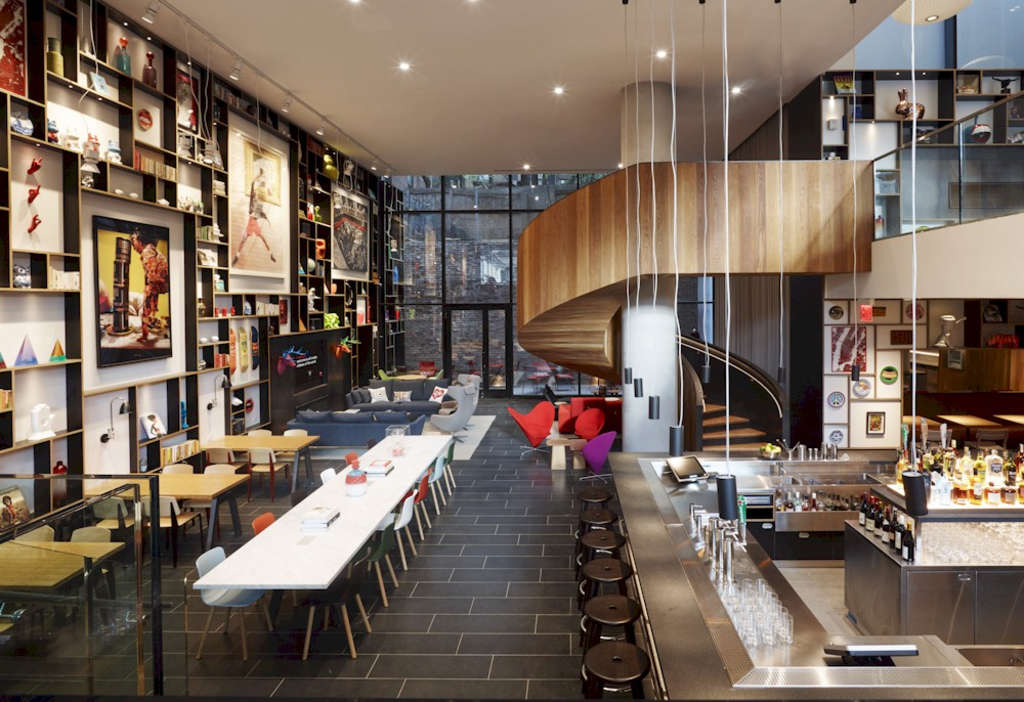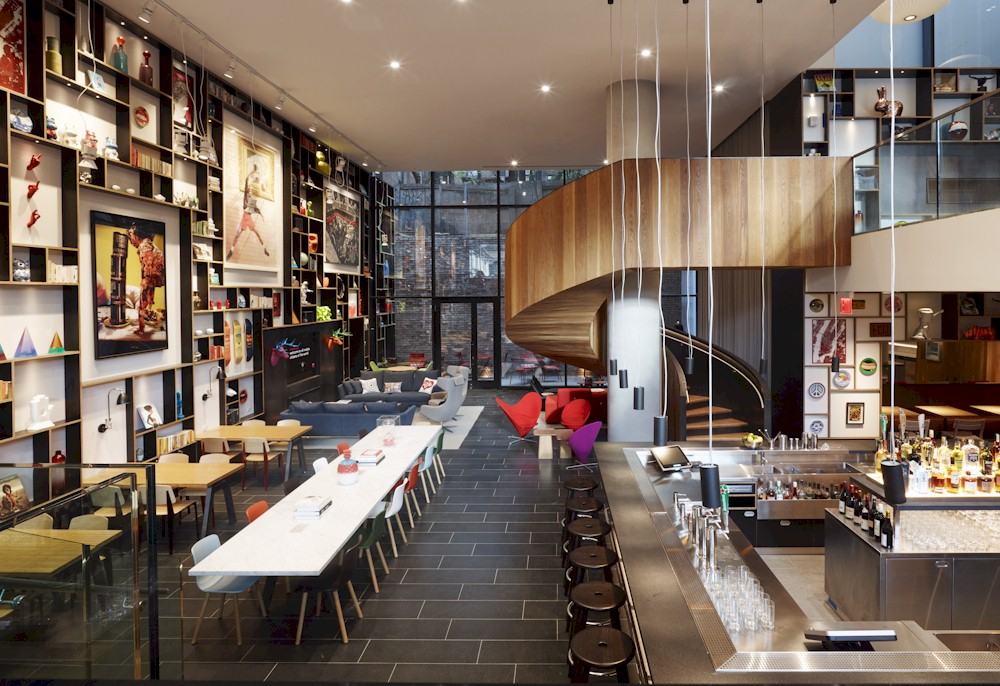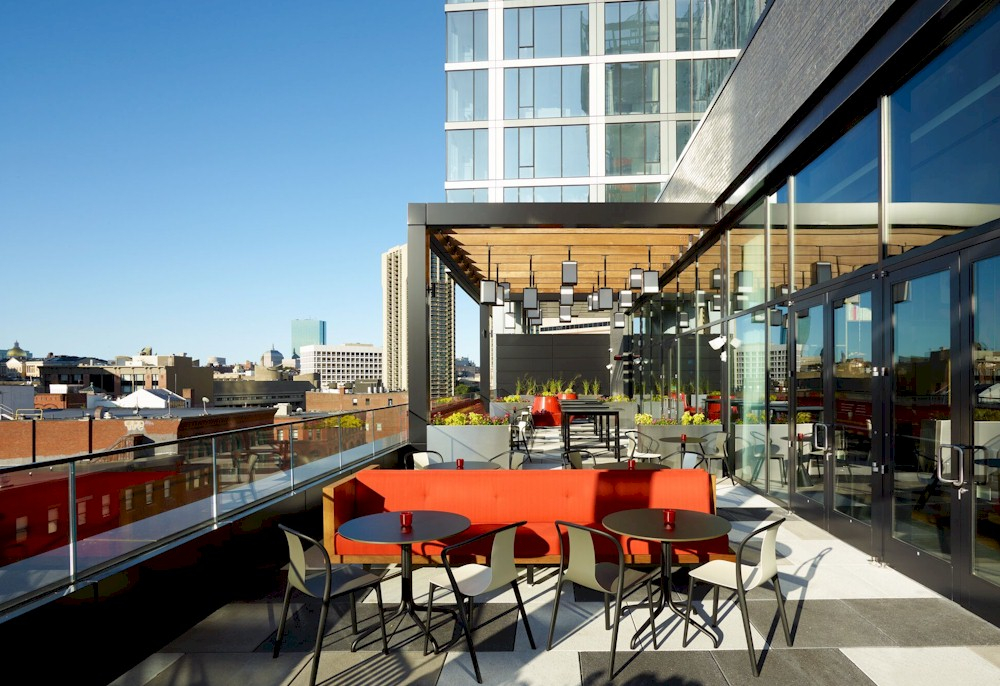Design Hotel Hybrid Work Environments for Evolving Guest Needs


As if the hotel industry weren't disrupted enough in the last decades, new approaches to hotel co-working are shifting the way many operators design and program their properties.
Today's work-life trends include new hybrid (remote and in-office) work schedules as well as solo, heads-down work and dedicated organization gatherings in "third places" including lifestyle hotel settings.
Many companies in tech, law, consulting and other professional services are now building – or maintaining – a "remote-first operational model," which encompasses solo co-working and varied kinds of remote in-person group work, including onboarding breakouts, company off-sites, and annual company retreats.
Leading hotels are supporting these mobile work lifestyles including "work from anywhere" (WfA) teams. The hotel company and lifestyle brand citizenM was founded with a prototype design - the first at Amsterdam's Schiphol Airport and now in 30-plus locations globally - that welcomed and promised to support what soon became known as co-working, predicting the rise of the mobile citizen (thus, our name citizenM) and an engaging hotel program with comfortable co-working offerings adjacent to lounge and food and beverage (F&B) settings, as well as meeting rooms equipped for varied kinds of meetings.
Working at the hotels has been part of citizenM's concept from inception. The public spaces have been designed to see teammates, clients, friends, family, the locals. Moreover, citizenM's design approach is to bring people together for whatever that purpose is – whether it's as a local coworker in our common areas, known as Living Rooms, a happy hour among friends at the cloudM rooftop bars, or on a business trip overseas. None of these ideas, all incorporated from day one, are reactive design gestures prompted by any short-term trends.
Adding to that, citizenM's public spaces need to serve primarily their guests but also offer a "third place" for local community members as well. The respective needs of guests and neighbors are quite distinct, and the architectural programming and interior design of citizenM hotel public zones are geared toward addressing the typical requirements of those two groups.
The challenge we addressed starting in 2008, and through to our more recent R&D efforts on WfA launched with our reLead Summits on the future of work in 2022, now faces all hotel operators: to lay out and design hotels for broader workplace acceptance and traffic as well as optimal remote-work lifestyles. That lifestyle aspect, too often neglected or relegated to low priority status, is critical: Examples that reinforce the lifestyle-first approach are seen in citizenM hotels around the United States, from New York to Los Angeles, Boston to Seattle, and in unique locations like the headquarters gate of Meta in Menlo Park, Calif.
Getting Started
To get started in reinventing longstanding hotel models and enhancing the more modern approaches like those seen at citizenM, hotel design teams need to first take a hard look at the post-pandemic situation. (Surveying the target guest base is a serious, quantitative way to get a fresh baseline understanding.) Overall, with advances in communication technology, the remote work phenomenon is widely accepted and people have discovered they can work from anywhere,
says HotelExecutive publisher Benedict Cummins. As a result, hotels are adapting by creating spaces to accommodate those travelers who wish to remain connected to the office while on the go.
He explains that lobbies are being transformed into co-working spaces, promoting community engagement, reinforcing brand loyalty, and increasing F&B sales.
From the standpoint of guests and their organizations, WfA and in-person options create an increasingly diffuse work environment, a significant opportunity for both organizations and employees. For workers, the greater flexibility can have life benefits, such as reduced commuting distance and more time at home or in personal pursuits. Employers potentially gain access to a wider pool of talent and may benefit from reductions in real estate portfolios, with less office space needed.
At the same time, many well-intentioned hotel transformations have missed the real opportunity for appeal and long-term loyalty. To see why, consider the concept of third places, which underlies guest satisfaction in co-working settings. According to The Brookings Institution, the term third places, coined by sociologist Ray Oldenburg, refers to places where people spend time between home ('first' place) and work ('second' place). They are locations where we exchange ideas, have a good time, and build relationships.
This nugget is the touchstone of design excellence in the new normal. For citizenM, it was a core organizing principle of our business model and an architectural partí for our first locations.
With that experience validated over almost two decades of planning and growth, it seems critical for all hoteliers to study some of these findings and apply them to their own hotel approaches. Consider these related dynamics:
- We see that after Covid, guests are staying longer at our hotels on average.
- Our current offer to the guests are meeting rooms, called societyM, as well as a hybrid work environment in the lobby-lounge hybrid areas we call our living rooms.
- Responding to guest preferences and the fact that they are spending more time with us, we've developed a design strategy to further differentiate the various work settings in our hotels.
- Responding to the varied needs of travelers and guests, including hybrid bleisure mobile citizens and the communities where our hotels have opened, we are creating ways to strengthen the opportunity for co-working.
- New offers for co-working include options for neighbors and city dwellers in the local community, as well as the addition of co-working as a discrete and rewarding element in the evolving citizenM membership program, mycitizenM+.
Unlike some global flags, citizenM debuted 15 years ago to challenge the traditional hotel model in the world's biggest cities - and to disrupt the hospitality industry by removing common frictions in the guest journey. As our founder Rattan Chadha puts it, We don't want to be just another building, we want to become part of the neighborhood's fabric while showing residents and visitors a different side of the city.
This led to pioneering the concept of "affordable luxury for the people," as our brand promise says, with a focus on well-connected locations in the world's most popular cities that we can turn into cultural landmarks of their own, with newly commissioned works of art by local artists in addition to convenience and novelty.
Creating a Powerful Third Place
Inside the typical citizenM hotel, entering guests experience a remarkable environment with conversation-starting artwork, comfortable high-end furnishings, a prominently located bar, and perhaps a signature architectural flourish. The programming and layouts try to keep all of the different public activities on the same floor. The diversity of these various movements, the buzz and varied activities creates a space that is energized and used at any time of the day (or night). At a glance, guests and visitors sense a design language that is intentionally bold, colorful and even provocative at times, so that the effect evokes an emotional reaction with guests.
The citizenM Bowery location in New York City features double-height ceilings, bookshelves, a signature 24/7 canteenM bar, and glass walls that stream abundant daylight and offer an open view to the plaza outside. Insiders and frequent guests know the special features and delights that may lie within any single location: running throughout the circulation core at citizenM New York Bowery, for example, is New York's one and only Museum of Street Art, with original graffiti works by some of the genre's biggest names.
Also, the 24-7 aspect is essential. At any time of day in any citizenM worldwide, a guest can ask for a cappuccino or a cocktail and settle down in plush designer furnishings to work, relax or socialize. The public zones let co-working, entertaining and F&B activate the third space, an essential for almost anyone who has ever worked in a bustling office or elegant executive suite. Yet a quiet nook is also possible - citizenM's Living Rooms are generous and well spaced. Behind glass partitions are the varied societyM rooms, double-glazed for acoustic privacy and with blinds for visual privacy, too. Not only activating our common areas, co-working by guests and transients also generates ancillary revenues through F&B sales.
As part of R&D into effective co-working and new trends in remote and hybrid-remote work, last year citizenM hosted the first in a remarkable series of programs called reLead Summit. Bringing together prominent "advocates" from around the United States for a retreat-style, two-day leadership ideation on the future of work, the design-thinking group brainstormed and huddled in breakout sessions, taking on a think-tank agenda to break new ground in the latest remote and hybrid-remote work concepts. It was organized by the leading membership community for remote professionals, Remotely One, and hosted at citizenM Washington DC Capitol, where the individuals and groups tested existing societyM rooms and co-working areas, as well as the hotel's cloudM rooftop bar with breathtaking views overlooking the city.
This national innovation summit revealed the state of today's work-life trends, described current needs, and predicted near-term trends. Their new remote work ideas and views on the future of work brought insights about lifestyle hotel settings, including solo co-working as well as multiple kinds of in-person group work, including onboarding breakouts, company off-sites, and annual company retreats.
The gathering broke new ground, but it also reinforced our primary design concept – essentially, cater for all moments in their journey – as well as the basics of workplace design, pushing us to better integrate work environment strategy into the hospitality setting. Among the priorities for design are flexibility, so that workers have more options and ways to decompress and relax or to dive into "focus work,
all in the same location. Meeting areas also need to adapt to technologies such as video conferencing and to varied group work setups. Second, good workplaces offer elements of art, biophilia and outdoor views, among others traits, which allow coworkers to rest their eyes, recharge and recalibrate, and then immerse once again into their work. Think about well-being in these aspects, as well as the choice of materials and finishes.
As the tech industry workplace revolution showed the world, the coffee bar and the playroom can make an otherwise straight office experience one that is special and engaging: companies want to create a stronger sense of belonging, and the workforce seeks to engage more fully with coworkers. So third, hotels need to offer these elements - foosball tables and board games, for example, as well as a centrally, easy-to-see espresso machine. (Of course, connectivity is important, and recharging devices is essential.) Fourth, workplace acoustics are very distinct from hotel acoustics, so it helps to study the best practices. A low hum of chatter, piped-in music, and soft guest noise set the stage for comfortable productivity, but table clearing and reverberant surfaces that echo are all mere disturbances. Can you hear other guests taking annoying phone calls? Perhaps there needs to be a new looks at space planning, another critical element to manage noise management. Skip this at your peril: It only increases the chances your coworkers will not remain so loyal to your location.
A position of sustainability is also important for longer-term loyalty and business success. Surveys show a large portion of remote workers are attracted to businesses and products that reflect a deep commitment to environmental, social and governance leadership. Hotels – just like any company today – need to take a clear position towards their efforts in contributing to a more sustainable way of designing, constructing, and operating their buildings. Guests and capital markets are setting challenging targets which can only be reached only through deliberate changes in material and product choices, building methodologies, technical operations and energy consumptions.
Co-Working IS Hospitality
Over the last 15 years, hotels have increasingly adopted the co-working model. It's fair to credit some local boutique hotels, some catering to tourism or discrete industries, for pushing this into a new era: They embraced wi-fi moochers and freelance nomads as early as 2009. In fact, they redesigned their lobbies to have hip food and beverage options, which further attracted millennials. A new business model was created, that is far more attractive than renting out loft space. As for citizenM, this approach seemed essential to the business traveler, which we developed just prior to that time.
In doing so, we watched the emergence of the WeWork model, which created a third place in cities by merging the corporate model with a lifestyle component: coffee places, lounge areas, communal work desks, and the like. The citizenM hotel lobby took this in a radical and valuable direction for business traveler hospitality, and several other other hotel brands have been following suit, more recently, as a result of WfA. The "old" lobby idea consisted of a counter and two sad chairs – there was no space allocated for guests to "dwell" in a ready-made setting. Melding the comforts of home with business, citizenM's Living Rooms feature stylish Vitra furniture and sculptural lighting fixtures, making working in a lobby, making working feel fun and connected.
Seeing they could bank on a higher occupancy rate for conference rooms, too, big hotel chains began working to deliver improved competing models, as at Marriott and Sheraton, two early adopters. Some of the common spaces in the Marriott International brands have more than doubled in size over the last five years, growing at a rate that is four times as high as that as the growth for the rest of the Marriott International portfolio. Sheraton hotels set out to revamp some 450 existing lobbies, adding "productivity tables" in their lobbies, replete with outlets, USB ports, and drawers that users could rent and lock. Some hotels added private phone booths in their lobbies, and made meeting room spaces easier to rent.
These efforts have had mixed results. The citizenM-hosted reLead Summit uncovered some of the impacts of architectural and interior design on the attraction and success of co-working audiences. They summed up the advantages of meeting at a "third office" option instead of the HQ office, and described what features, benefits, and cultural elements remote teams look for when selecting an on-site destination. Comparing hotel options to co-living spaces or privately owned residences, they defined the advantages in the hospitality world - a revealing and fascinating peek into the mindset of workforce nomads.
One of the most valuable insights is worth sharing: Seeing specific signs that a company's distributed team might need an in-person gathering, human resources professionals and managers are more often calling for in-person options today. These include:
- Onboarding Retreats. Used by virtual-first organizations with minimal real estate, these work gatherings enhance virtual onboarding for new hires with in-person interaction for more instantaneous leadership visibility, cultural immersion, and relationship building.
- Company Off-Sites. These are increasingly popular for any hybrid or virtual-first team who has limited access to company-provided real estate for in-person gatherings or wants a "third office" option to optimize creativity.
- Annual Company Retreats. Ideal for any hybrid or virtual-first organization that gathers their distributed team together at least once a year for a workforce retreat for culture development, annual planning, and/or employee recognition program, these programs benefit greatly from a conducive, well-designed hospitality offering.
These findings, and others being tracked by citizenM, reinforce some things many hospitality leaders already assume: First, statistics still show that co-working is here to stay. Compared to the uncertainty surrounding companies like WeWork and the lack of panache seen among many large hotel brands, a more sustainable model can be seen in the public spaces of citizenM hotels. Another example is Denizen – basically an Airbnb model for workspaces – which seems to hold promise. These third places respond uniquely to locale; there is no cookie-cutter formula. They meld tourism and the local workforce, too.
Ideal for our business model, citizenM's co-working design provides repeat business because of the hotel amenities and attractive interior design. The citizenM hotels with flourishing co-working scenes such as in London and New York illustrate the appeal. These settings benefited from some foresight: There were already built-in conference spaces that have shown a greater degree of occupancy. And our common areas are built around a different kind of guest, and the local community, with the flexible approach they need. For these reasons, we expect they will continue to attract the increasingly itinerant workforce.
Reprinted from the Hotel Business Review with permission from www.HotelExecutive.com.



